Sharlyn J. Lauby's Blog, page 34
August 29, 2023
Wage Garnishments: Manage Them Effectively, Efficiently and With Empathy

Estimated reading time: 5 minutes
(Editor’s Note: Today’s article is brought to you by our friends at ADP ® , a comprehensive global provider of cloud-based human capital management (HCM) solutions. You can stay up to date on HCM topics with the ADP Spark blog . Check it out when you have a chance. And enjoy the read.)
Last year, I published an article about wage garnishment compliance and risk avoidance. In the article, we highlighted three things.
Wage garnishments happen more than we might think. In the ADP Research Institute white paper “The U.S. Wage Garnishment Landscape: Through the Lens of the Employer”, they report that 1 in 14 employees is subject to some form of wage garnishment. The most common type of garnishment is related to child support (50% +) with tax levies being second (19%). The report indicates that the highest number of garnishments are employees between the ages of 35 and 54. This group also has the highest wage garnishment rate. And approximately one in one hundred people have more than one garnishment. Different states have different laws pertaining to wage garnishments. For example, states might have different requirements regarding when garnishments are paid, how many garnishments an employee can have at one time, any deduction limits, and the fines to employers for not properly processing garnishments.Improper and insensitive handling of wage garnishments – even unintentionally – may create a lot of employee dissatisfaction. That’s what I want to talk about today – handling wage garnishments effectively, efficiently, and respecting employees along the way. Putting the “Human” Back into HRThere’s this little phrase that I sometimes hear in HR about putting the “human” back in human resources. Regardless of your feelings about the phrase, my take is that the intent is for HR departments to be empathetic (aka be more “human”). HR should remember what it’s like to be a candidate to develop a positive candidate experience. HR should remember what it’s like to be a new hire to design a welcoming and effective onboarding experience.
And even if we’ve never personally had a garnishment, we should remember what it’s like to be an employee who is looking for answers, privacy, and discretion in managing the wage garnishment process. The way we can do that (meaning bring more empathy into HR) is by allocating our resources effectively and efficiently. Which in turn, will allow us to spend a little more time focusing on empathy. We can specifically use this idea when it comes to managing wage garnishments.
HR departments should spend their time on things that only they can do. This is how they become effective and efficient. We often talk about this when we think of technology. Let the technology do what it does best, and HR will focus on what it does best.
This same philosophy applies to wage garnishments. Find a solution that does garnishments well so HR can spend their time focused on the employee experience.
ADP’s Wage Garnishment SolutionOur friends at ADP have a wage garnishment processing and disbursement solution that helps organizations reduce administration, improve compliance, and mitigate risk. The ADP wage garnishment solution ensures that:
Organizations are following each state’s garnishment laws.Accrued funds are dispersed in a timely manner, including electronically when required. ADP experts are available to offer assistance for complex garnishment orders or when an employee has more than one garnishment.Reports are available for organizations to monitor and audit the status of garnishments.I know some of you might be saying, “This sounds wonderful! But we don’t use ADP payroll.” No worries. Their wage garnishment solution is a stand alone feature and integrates with the top ERPs (enterprise resource planning software). So, you don’t have to be an ADP client to take advantage of this solution.
This type of solution allows organizations to … as I mentioned earlier, put the “human” back in HR. Let’s face it, often when employees have a question about their paycheck, they go to HR first for answers. Can HR and payroll work together to manage wage garnishments? Of course. But it takes a lot of time. That’s time HR and payroll could be spending on other things.
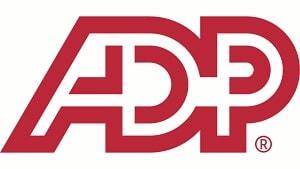
The ADP Wage Garnishment solution allows HR and payroll to spend their time with the employee – answering questions, etc. That’s what the employee wants to know – how their garnishment works. And they want it handled with the sensitivity and respect it deserves. ADP can take care of the filings and help accomplish the organization’s goal of having an effective, efficient, and compliant process.
Organizations Should Manage Their Resources WellI’ve mentioned before that as HR professionals, just because we can do something doesn’t mean we always should. I believe that organizations are hyper focused on being effective and efficient right now – which means that they’re looking at their current processes for opportunities to reallocate resources.
To help you manage wage garnishments, ADP has put together a checklist for employers. It’s a great representation of how complex garnishments can be and all the individual steps that need to be done. This is a good place to start looking at your wage garnishment process and evaluate where the organization wants to be hands-on and where a partner makes good business sense.
The post Wage Garnishments: Manage Them Effectively, Efficiently and With Empathy appeared first on hr bartender.
August 27, 2023
E-Verify: What Organizations Need to Know – hr bartender
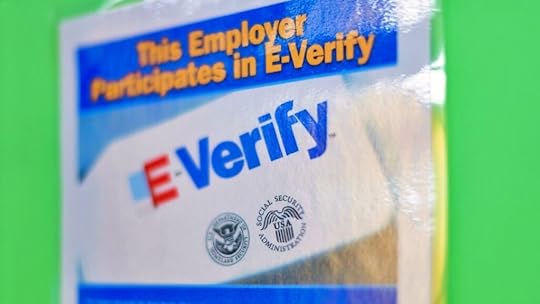
Estimated reading time: 5 minutes
(Editor’s Note: Today’s article is brought to you by our friends at Poster Guard® Poster Compliance Service, a division of HRdirect and the leading labor law poster service that gets your business up to date with all required federal, state, and local labor law postings, and then keeps it that way — for an entire year. Enjoy the article!)
I must admit that I haven’t thought much about E-Verify lately but a couple of news articles caught my eye, so I wanted to share. But before I talk about the articles, it might be helpful to do a quick refresher.
Under the Immigration Reform and Control Act (IRCA), all U.S. employers are required to complete Form I-9 whenever they hire someone. Basically, Form I-9 verifies that the new hire is who they say they are and that they’re eligible to work in the United States. That was the first *E-Verify* related article I saw. There’s a new Form I-9 and employers must switch over to the new version by November 1, 2023. (I promise we will talk about the new Form I-9 in detail soon.)
So, what does the new Form I-9 have to do with E-Verify? E-Verify is an internet-based system that compares the information on an employee’s Form I-9 with records available to the U.S. Department of Homeland Security and the Social Security Administration. While using E-Verify is voluntary for most businesses, organizations with government contracts might find that E-Verify is a contract requirement.
And some states are passing legislation requiring organizations to use E-Verify. That was the second *E-Verify* article I saw. My state (Florida) just passed a new law requiring private employers with at least 25 employees to use E-Verify. Now, this might not mean a lot if you don’t have employees in Florida, but in doing some research I discovered that 27 states have some sort of E-Verify requirement.
So, this change in Form I-9, coupled with state legislation requiring E-Verify, could be a perfect time to look at your processes.
If you’re currently using E-Verify, make sure that you’re in compliance. This includes labor law posting requirements. Organizations that use E-Verify are required to provide job applicants with access to the latest E-Verify and Right to Work posters. In addition to applicants and candidates, employees must be able to see the postings as well.
If you’re not sure if your postings are current OR you would like an easier way of managing your postings, our friends at Poster Guard offer two posting services related to E-Verify and Right to Work.
The E-Verify Poster Service provides the posters that every employer participating in the E-Verify program must display. There’s also an add-on E-Verify Posting Service for online job applicants, since they must be able to see these postings.It’s an electronic service that for 12 months is updated in real-time as regulations are changed. And it’s bilingual (English and Spanish). Like the rest of Poster Guard’s services, it comes with a 100% guarantee that the posters are compliant.
Now, if you’re not currently using E-Verify, given the new updates to Form I-9 … this could be a good time to consider adding it to your process. There are two big reasons for adding E-Verify to your existing process: 1) compliance and 2) administration.
Compliance. E-Verify helps employers reduce the risk of hiring workers who are unauthorized to work in the U.S. through the employment eligibility check. It includes a photo matching option that allows employers to compare the photo provided by the employee when certain documents (i.e., from List A such as a passport or resident card) are presented for verification. This allows employers to establish a rebuttable presumption that they have a system in place to prevent hiring employees who are unauthorized to work.
Administration. E-Verify also allows employers to utilize I-9 software and eliminate manual data entry – saving time, money, and potentially reducing data errors. This also means that organizations can monitor document expiration dates to ensure compliance. This electronic system would make it easier to store and maintain documentation. And should the organization ever find themselves in an audit situation, they would be able to respond in an effective and efficient manner.

Sometimes when there are labor law changes, it makes sense to look at the entire process not just one step. I think this is one of those moments.
The upcoming changes to Form I-9 are an opportunity to make sure that the organization is in compliance with both Form I-9 and E-Verify. Organizations can confirm they have the most current forms and the required postings. And if there are opportunities to partner with a company like Poster Guard, this shifts the process from being reactive to proactive.
And if the company hasn’t adopted E-Verify, now is the time to have a conversation. Services like E-Verify are designed to protect employers and employees. Employers know that they’re hiring someone who is authorized to work. And employees know that the organization is following the law by hiring individuals who are authorized to work.
The post E-Verify: What Organizations Need to Know – hr bartender appeared first on hr bartender.
August 24, 2023
Bookmark This! Employee Value Proposition Edition – hr bartender
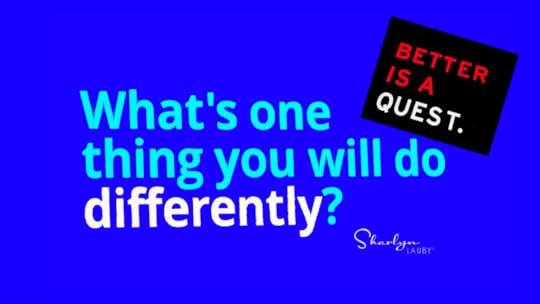
Estimated reading time: 3 minutes
One of the topics I’m hearing more organizations focus on is the employee value proposition (EVP). Basically, the EVP is what employees receive for working at the organization. Of course, it includes compensation and benefits, but it also includes more than that. Other common components of the EVP include training, quality of the management team, work / life balance, wellbeing, and even corporate social responsibility (CSR).
The idea behind the employee value proposition is that all these components work together to create the employee experience. Organizations do not have to be the biggest and best in all categories. For example, I’ve worked places where I didn’t have the highest salary, but I did have a lot of flexibility when it came to time off. I’ve also worked places where I didn’t have scheduling flexibility, but I did have access to great training. The goal in creating and promoting an EVP is to put together the right mix of components that will help the organization attract, engage, and retain talent.
If you’re thinking about the organization’s EVP, here are some articles to get you started.
5 Currencies Essential to Your Company’s Employee Value Proposition
Organizations need to make sure their EVP is competitive and being communicated. Frankly, even in a less competitive job market, it just makes good business sense to promote this information. Letting employees know the currencies – both monetary and non-monetary – that they will receive helps them decide whether to work and/or stay with an organization.
The 3 Things that All Employees Want
Organizations are going to be refining their policies and procedures for a variety of reasons. Maybe to accommodate hybrid and remote work. Possibly to accommodate a changing workforce. Whatever the reason, co-creation could be a good design strategy. And the 3P’s can be a way to guide the conversation.
4 Workplace Guarantees Every Employee Should Have
Many organizations promote that their employees are their business. They say that their talent is what sets them apart from their competition. Then now is the time to commit to a Charter of Workplace Rights that tells the world that the company is serious about it.
Employee Benefits: Make Them Easy to Buy and Use
Employee benefits are an important part of the employee value proposition (EVP). But if organizations want employees to feel like they have the best benefits package ever, then they need to market those benefits. And make them easy to buy and easy to use for the employee.
How to Evaluate Your Employee Value Proposition
Now could be a perfect time to see how your EVP looks visually, like in a quadrant model. Ensure you have a balanced offering of components that will be attractive to candidates in the short-term and career-focused employees in the long-term.
Regardless of what your organization is doing right now from a recruiting perspective, the organization’s employment brand is important. Which means the employee value proposition (EVP) is important. Regularly reviewing the EVP to make sure it’s balanced and in alignment with employee feedback can help the organization remain competitive in attracting and retaining talent.
Image captured by Sharlyn Lauby at the SHRM Talent Conference in Orlando, FL
The post Bookmark This! Employee Value Proposition Edition – hr bartender appeared first on hr bartender.
August 22, 2023
Workplace Investigations: The Best Way to Finalize Them and Mitigate Risk

Estimated reading time: 5 minutes
(Editor’s Note: Today’s article is brought to you by our friends at Case IQ (formerly i-Sight ), a leading provider of case management solutions that helps companies manage the process and workflow of investigators collecting and analyzing information related to a case, with the goal of resolving issues, managing risk, and identifying opportunities for improvement. Enjoy the read!)
Workplace investigations are an important activity for human resources departments. Even if you don’t do them all the time, it’s important to be trained on how to properly conduct an investigation. And even when we – as HR professionals – don’t personally conduct the investigation it’s still important that we know the process. For example, it’s possible that given the nature of the investigation and individuals involved, we might want to use an external resource like a consultant or attorney.
Today, I want to focus on one specific and critical step in the investigation process. And it might not be the one you expect. I want to focus on the last step, which is closing the investigation. But before we do, let’s do a quick recap of the investigation process.
PRE-INVESTIGATION. When HR hears about a concern or complaint, there are a few things they need to do starting with evaluating whether an investigation is necessary. Sometimes an employee might share a concern and they simply need good information like being educated on a policy they’re not aware of.
During the pre-investigation phase, a plan should be developed. This includes who will be involved on the investigations team, the objective, and the timeline. Sometimes an investigation is driven by a collective bargaining agreement (CBA) but other times, there needs to be some sort of plan and timeline to keep things on track.
INVESTIGATION. Provided that it’s determined an investigation is necessary, then the information gathering begins. HR will collect data from existing systems and files. It’s not uncommon to review employee files or previous investigation files. Then the investigations team will conduct interviews.
ANALYSIS. From the information gathered during the investigations phase, the findings will be analyzed, and recommendations developed. There are two kinds of recommendations. The first type is related to the objective of the investigation (i.e., was the claim/concern substantiated?). The second is related to the process (for example, maybe the company had to do a video interview for the first time. Any recommendations for future workplace investigations?).
This brings us to closing the investigation. The recommendations (above) will determine what action the organization decides to take regarding the investigation itself (i.e., disciplinary action, termination, etc.). It will also provide some discussion about how to handle future investigations. For example, the organization might find that they were impressed with the work of the outside consultant and want to use them more often.
The organization will also want to consider whether the details of this investigation would be a good scenario to “sanitize” and use in future training sessions. One of the challenges I hear about training content is that custom training programs are expensive and off-the-shelf training programs aren’t specific enough. Organizations might be able to remove identifying information from internal incidents and use them as case studies in training programs.
Next, HR needs to close the loop with key stakeholders:
This includes the person who voiced the concern / complaint. Regardless of the outcome, they need to know the organization took their concern seriously. The individual(s) who were the subject of the concern / complaint. Especially if the investigation was inconclusive or did not substantiate the complaint. The people who were interviewed during the investigation. With key managers whose employees were a part of the investigationWhen talking with individuals about the investigation there are three key messages to get across:
Thanking them for their patience, support, and participation.Reminding them that the investigation should remain confidential.Letting them know the organization has zero-tolerance for retaliation.HR will be responsible for preparing any final documentation. Whether the investigation was conducted by HR or an outside party, the documentation needs to be collected and filed. As a side note: If you’re looking for the best way to maintain your investigation files, you should speak with your friendly labor attorney.
This is also a good time to log the final outcomes of the investigation into a case management solution. And I don’t mean your human resources information system (HRIS). A case management solution would be searchable so you can refer to past decisions to maintain consistency and compliance. HR can also use a case management solution to look for trends and potentially identify a pattern that needs to be examined further. It’s an opportunity to proactively address trends before they become concerns / complaints and turn into investigations.

It might be very tempting to simply say, “Investigation over, employee fired, we’re done.” Or “Investigation over, didn’t find anything, we’re done.” That’s not true. Wrapping up an investigation does several things.
It lets interested parties know the investigation is finalized. They deserve to know. It tells the organization that complaints and concerns will be taken seriously and will be looked into. Employees will not share their concerns if they don’t feel that HR and the company will listen. The employee might choose to leave the company. Or decide to share their concerns with an outside party, like a lawyer or government agency.By properly conducting and tracking investigations, the organization can look at data relating to how many investigations the organization is doing, how long they take, what they are related to, and more. The organization is positioned to proactively address workplace issues that could result in fewer investigations overall. And increase employee engagement.
If you want to learn more about workplace investigations and in particular, how your investigations process can help the organization proactively address employee concerns, check out this Case IQ ebook on the Investigations Maturity Model. Also, I recently conducted a webinar with Case IQ on organizational ethics and workplace investigations where we spent some time talking about how to properly wrap up an investigation. You can listen here. I hope you will.
The post Workplace Investigations: The Best Way to Finalize Them and Mitigate Risk appeared first on hr bartender.
August 20, 2023
Workplace Ethics [Episode 2]: Heather Bussing on HR’s Role in Investigations
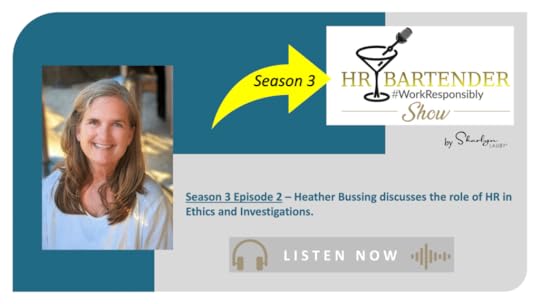
Estimated reading time: 3 minutes
One of the biggest responsibilities HR professionals have is managing investigations. We might not be investigating something all the time, but when we do, it’s important that we get it right. It starts with employees feeling comfortable with bringing concerns to their manager or HR.
But listening to employee concerns can also raise challenges for HR. Sometimes, employees just want to vent. Or they don’t want anyone to know that they’re talking to HR. This doesn’t mean we should make it difficult for employees to express their concerns. However, as HR professionals, we have an obligation to investigate when needed.
That’s why I’m thrilled in this episode of The HR Bartender Show to chat with Heather Bussing. She is a California employment attorney with over 30 years’ experience providing sensible and strategic advice to employers. Her deep experience with business, humans, technology, and work gives her a unique perspective focused on preventing and solving problems rather than fighting about them.
Heather has been interviewed and quoted in the New York Times, Wall Street Journal, CNN, Business Insider, and NPR. She also teaches Legal Writing and Internet Law. Also, a quick P.S.! Please don’t forget that Heather’s comments shouldn’t be construed as legal advice or as pertaining to any specific factual situations. If you have detailed questions, they should be addressed with your friendly neighborhood labor and employment attorney.

Just because one of HR’s roles is to manage investigations, it doesn’t mean we have to conduct all of them. For example, knowing when to bring in outside expertise is an important decision. It could be in the best interest of everyone involved to utilize the services of an outside professional.
Where HR does play a critical role is helping the organization regain trust after an investigation. Sometimes investigations can chip away at organizational safety and trust. Helping employees and organizations after an investigation is something absolutely necessary and we don’t spend nearly enough time talking about it.
If you want to connect with Heather:
LinkedIn https://www.linkedin.com/in/heather-bussing-785122161/
Twitter https://twitter.com/heatherbussing
During the show, I promised to share with you a few of my favorite interviews with Heather.
Social Media Background Checks: Are They Okay?
Companies: When to Call a Labor and Employment Lawyer
When to Tell Your Employer that You’re Pregnant
Season 3 Episode 2 – Attorney Heather Bussing Notes
Season 3 Episode 2 – Attorney Heather Bussing Transcript
Thanks for listening to our podcast. This season of the HR Bartender show is brought to you by our friends at Case IQ, the leading provider of modern investigative case management software to handle virtually any type of workplace incident. With millions of cases resolved, and billions of dollars in litigations avoided, trust Case IQ to help you protect your employees, your organization, and your brand.

You can subscribe to The HR Bartender show on Apple Podcasts, Spotify, Google Podcasts, TuneIn, and wherever you can listen to your favorite podcasts. And we would absolutely love it if you would leave a review.
The post Workplace Ethics [Episode 2]: Heather Bussing on HR’s Role in Investigations appeared first on hr bartender.
August 17, 2023
Employee Suspension: Tell Them Why They are Suspended – Ask #HR Bartender

A few months ago, I shared with you a Reddit community called “AntiWork”. If you haven’t checked it out, it’s worth reading occasionally. The community isn’t opposed to work, as the name might suggest. It’s actually more about employees sharing the really questionable things that employers do. The reason I’m reminded of the Reddit AntiWork group is because of today’s reader question.
I am an over the road (OTR) truck driver. I live in Alabama and I’m in Kansas on a load for the company I work for. I need to know if the company can suspend me without pay for 7 days when I’m away from home with no lodging.
I really hope this person was able to get answers to their question. Unfortunately, there’s a lot of information we don’t know so it wouldn’t be fair to try to guess. We don’t know what the employment laws are in Alabama. We don’t know what state the company is based in and their state laws. Because this is trucking, are there any federal transportation laws that need to be considered? And we don’t know why this person might be suspended.
That’s where I want to go with today’s conversation. Organizations need to tell an employee why they are being suspended. Period. And if there’s some reason the employee needs to be suspended mid-trip, I’d like to think that HR has discussed the implications with legal counsel. Including the implications of leaving someone in another state without pay or lodging.
As an HR professional, I could think up a scenario where an employee needs to be relieved of duty in the middle of a trip. What I’m struggling with is just leaving the employee in another state with no way to get home. Which takes us back to the reader note. While we don’t have enough information to specifically address the question, if you’re an employee who has been suspended, here are a few articles that might help.
How to Handle an Employee Suspension – Employees cannot correct or improve their behavior if they don’t know what they did wrong. That’s the purpose of coaching and discipline – to correct an employee’s behavior.
This is What You Should Do if You Get a Suspension – While organizations should be providing employees with information during suspensions, I also believe that sometimes the employee is in shock about what’s going on and they forget to ask. If companies want to get to the truth, then they need to answer employee questions. It’s incredibly unprofessional to leave an employee in limbo.
How to Respond to Being Placed on Suspension – Employee suspensions are complicated situations. Many things need to be considered, including the employee figuring out their ultimate goal.
Employees’ When You Should Lawyer Up – No one wants to escalate issues to lawyers and government agencies, but unfortunately, sometimes it just has to be done.
I’ve always felt that even when you’re suspending or terminating someone, it should be done with respect. Even if the employee never demonstrated any respect to the company. Organizations should absolutely do the right thing. The organization – and its brand – will benefit in the long run.
Image captured by Sharlyn Lauby while exploring the streets of New Delhi, India
The post Employee Suspension: Tell Them Why They are Suspended – Ask #HR Bartender appeared first on hr bartender.
August 15, 2023
WORKPLACE ETHICS [Episode 1]: Why Ethics is Owned by Everyone
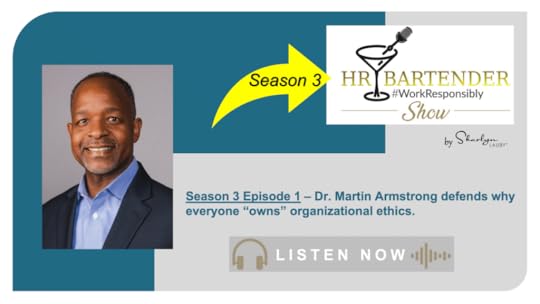
Estimated reading time: 3 minutes
This season of The HR Bartender Show is focused on workplace ethics. According to research from the University of Notre Dame, organizations with ethical cultures outperform their competition AND companies with less than ethical cultures see a negative impact on performance. It totally makes sense. Customers want to do business with ethical organizations. Employees want to work at ethical companies.
To start this season’s conversation about ethics, I’m delighted to chat with Dr. Martin Armstrong, vice president of payroll shared services for Charter Communications, a Fortune 100 company in the United States. Charter Communications is a $54B cable operator with 32 million customers and over 103,000 employees in 44 states.
Dr. Armstrong has been a Certified Payroll Professional (CPP) since 1990 and holds a Doctor of Business Administration (DBA) degree from Argosy University. His dissertation concentrated on employee readiness for organizational change. In addition, he has authored over 45 published articles and has extensive training in performance metrics, process improvement methodologies, change management, strategic tax planning, and mergers & acquisitions.
In this episode, we talk about ethical cultures and the importance of recognizing and eliminating opportunities for unethical behavior.

One of the reasons I’m excited to talk about ethics this season is because I believe we need to talk about ethics more often. Organizations can reduce opportunities for unethical behavior when they communicate about ethics and expected behavior.
It can be very tempting to not discuss ethics because we don’t want people to think we don’t trust them. It’s really the opposite. We build trust by having an ethical standard and talking about it. That’s how ethical behavior becomes part of the company’s culture – because employees embrace it.
You can connect with Dr. Martin Armstrong via LinkedIn.
Season 3 Episode 1 – Dr. Martin Armstrong Notes
Season 3 Episode 1 – Dr. Martin Armstrong Transcript
Thanks for listening to our podcast. This season of the HR Bartender show is brought to you by our friends at Case IQ, the leading provider of modern investigative case management software to handle virtually any type of workplace incident. With millions of cases resolved, and billions of dollars in litigations avoided, trust Case IQ to help you protect your employees, your organization, and your brand.

You can subscribe to The HR Bartender show on Apple Podcasts, Spotify, Google Podcasts, Stitcher, and TuneIn. And we would absolutely love it if you would leave a review.
If you enjoyed this episode, be sure to check out other episodes on our podcast page.
The post WORKPLACE ETHICS [Episode 1]: Why Ethics is Owned by Everyone appeared first on hr bartender.
August 13, 2023
Make Your Organization Unique – hr bartender

Estimated reading time: 3 minutes
I’ve always worked for organizations where people made the difference. For example, in the hotel industry, every hotel has beds, showers, etc. It was the people – the employees – who made the difference. Even when hotels started promoting upscale beds, pillows, and fancy bathroom amenities. The difference was people.
And I’ve always equated that “people are a key differentiator” to employees being able to do their jobs well. Meaning that employees have the skills and resources to do their jobs well. But during this year’s Society for Human Resource Management (SHRM) Talent conference, the event emcee spoke about uniqueness being a key differentiator.
The comment stuck with me, and I’ve been pondering it ever since. Is it possible that when we think about what makes our organization special, it’s not just skills but uniqueness? If that’s true, what does uniqueness look like? In fact, maybe that’s a question organizations need to ask themselves. If the company hasn’t dedicated time to explore this, here are a few questions to start the conversation:
What makes our organization unique? And doing what I did above and just saying “our people” isn’t enough. What is it about our people? If one of the company’s salespeople had to explain to a potential customer what makes the company different, what would they say? Sure, they would talk about skills. But I have to think they would also want to mention something that sets the organization apart from the competition – that’s the uniqueness factor.
How are we incorporating this information in our hiring process? Whatever the company defines as their uniqueness factor needs to be identified in potential employees. So, let’s say the company’s uniqueness factor is that employees are empowered to take care of customer requests. No “I’ve gotta ask a supervisor.” Well then, asking interview questions about empowerment or handling customers should be a part of the interview.
Where do we talk about our uniqueness during onboarding? Organizations should have time allocated in their orientation and onboarding to discuss the company history, customers, and products / services. Part of this presentation should include what makes the organization unique. Companies want their employees to be extensions of the sales team. That means telling employees the company’s uniqueness factor and how they achieve it.
Do our training programs give employees skills AND uniqueness? Talking about the uniqueness factor during interviews and during onboarding is important. Reinforcing the uniqueness factor during subsequent trainings is equally important. I can’t help but think that the whole exercise of identifying what makes the organization unique only works if it’s constantly being reinforced and training activities is a great place to do it.
Are we discussing uniqueness in one-on-one meetings and during performance conversations? This could be a place where organizations can measure an employee’s effort. For example, the organization can use a behaviorally anchored rating scale (BARS) to identify satisfactory performance (i.e., skills) and outstanding performance (i.e., uniqueness). Then, performance conversations can help employees work toward achieving a higher level of performance.
With all the talk about the economy and financial performance, organizations should be very focused on what makes them stand out from their competition. It seems to me that’s the uniqueness factor. If a company says, “We do what everyone else does and we do it exactly the same as everyone else.” well, that’s not really a compelling argument to buy your product or service. Now could be a perfect time to have a discussion about what makes the company unique and then ensure there are systems in place to support it.
The post Make Your Organization Unique – hr bartender appeared first on hr bartender.
August 10, 2023
Organizations: Your Social and Political Views are Part of Your Brand

Estimated reading time: 3 minutes
I recently read a point/counter-point type article in HR Magazine focused on “Should Employers Take Positions on Social and Political Issues?” It was an interesting read. Don’t take this the wrong way, I’m not sure there was anything new or surprising in the article.
One person articulated the view that candidates, employees, and customers prefer to engage with organizations that have a positive impact on society. And that’s totally true. Now more than ever, we make decisions about the products and services that we purchase based on the reputation of the company. And that includes whether we feel they are a good corporate citizen.
The other person voiced their view that taking a stand can alienate candidates, employees, and customers. Also true … especially if your view is unpopular. And let us not forget that not taking a stand in itself can be perceived as an intentional decision – and alienate people. When everyone around you is taking a stand and you’re not, well … it kinda stands out.
As we’re starting to talk about the 2024 U.S. election cycle, this could be a good time for the organization to have an intentional conversation about their views. Because the organization’s social and political views are a part of their brand. Even if the company’s view is “We’re not going to comment on social and political matters.”, that becomes part of your brand. Because in today’s business environment, “no comment” is not a neutral statement.
I’m not here today to tell you what to believe and support. You’re smart and can do your own research. But I did want to remind everyone to find time to do your homework for yourselves and the organization. Developing an opinion about some of the most pressing issues facing business and society isn’t going to happen overnight.
Some readers might be saying to themselves, “Thanks for the reminder. We went through this exercise a few years ago. We’re good.” I think that’s great. I would suggest that the organization make sure their position a few years ago is still their position today. It’s possible that something might have changed. And that’s okay. Sometimes, we just need to take a moment to confirm the organization’s position.
I wish I could say that the upcoming election cycle is going to be boring and uneventful. But I think we all know that would not be true. Organizations need to talk about their views – even if it’s to say we’re not going to talk about it – because it directly impacts their brand and bottom line.
Image captured by Sharlyn Lauby while exploring the streets of Jacksonville, FL
The post Organizations: Your Social and Political Views are Part of Your Brand appeared first on hr bartender.
August 8, 2023
HR Departments Need to Prepare for Delivering Value

Estimated reading time: 3 minutes
One of the regular conversations that surrounds human resources departments (and HR pros) is the ability to deliver value. There are countless articles about the need to become more strategic and transformational. I don’t really want to talk about that today. What I want to talk about is being prepared.
McLean & Company, a global research and advisory firm, recently sent me their “Future of HR” report. Yes, it contains some of that “be more strategic and transformational” discussion. But don’t let that deter you from checking out the report because it also had a very interesting point that caught my eye. It talked about how prepared HR departments (and HR professionals) are for the future. For example, the report indicated that HR is very prepared in the areas of:
Corporate social responsibilityDiversity, equity, and inclusionEmployee health and wellbeingWhich is great. These are important topics for employees and the business. They directly impact the organization’s brand. On the flip side, the report said that HR isn’t very prepared in these areas:
Technology and analyticsSkill developmentManaging internal talentI will admit, this was difficult for me to process. Not as much the technology and analytics part because I’m seeing people evaluating their relationships with technology. Or maybe the better way of putting that is people are reevaluating their relationships with technology. I believe everyone realizes that they have to get prepared for new technologies all the time – both in their personal and professional lives. And I believe that people are still trying to figure out the best way of testing and evaluating new technologies. They’re also trying to figure out under what conditions they should quit a technology, like a social media platform.
What I had challenges with was HR appears to be less prepared with skill development and managing internal talent. I’ve always viewed HR as being the architect of work. We help organizations create work that meets the company’s goals and employees want to do. So, HR needs to design interesting, attractive, and productive work. But if HR departments (and HR pros) aren’t well prepared to help their organization with skill development, then how will they create work? And if we’re unable to create work, how will HR help manage internal talent? Definitely something to think about.
The Future of HR report also reminded me of the importance of HR departments evaluating their own function. Yes, HR needs to be a part of strategic planning and operational planning. But in addition to those activities, maybe it makes sense for HR to do their own strategic and operational plan? This is an opportunity to ensure alignment with the organization. Plus it’s an opportunity to use traditional strategic planning tools like a SWOT analysis (Strengths, Weaknesses, Opportunities, Threats) and identify where the HR department needs to be more prepared.
Think of HR getting prepared like emergency preparedness. We don’t always know the type of emergency we’ll be dealing with and the same holds true here. The business world is constantly changing. But we can evaluate our situation, acknowledge our strengths, address our challenges, and develop a plan. The more prepared we are, the better we can react to the changing needs of the organization. And the better we can be at delivering value.
Image captured by Sharlyn Lauby while exploring the streets of San Diego, CA
The post HR Departments Need to Prepare for Delivering Value appeared first on hr bartender.
Sharlyn J. Lauby's Blog
- Sharlyn J. Lauby's profile
- 10 followers



